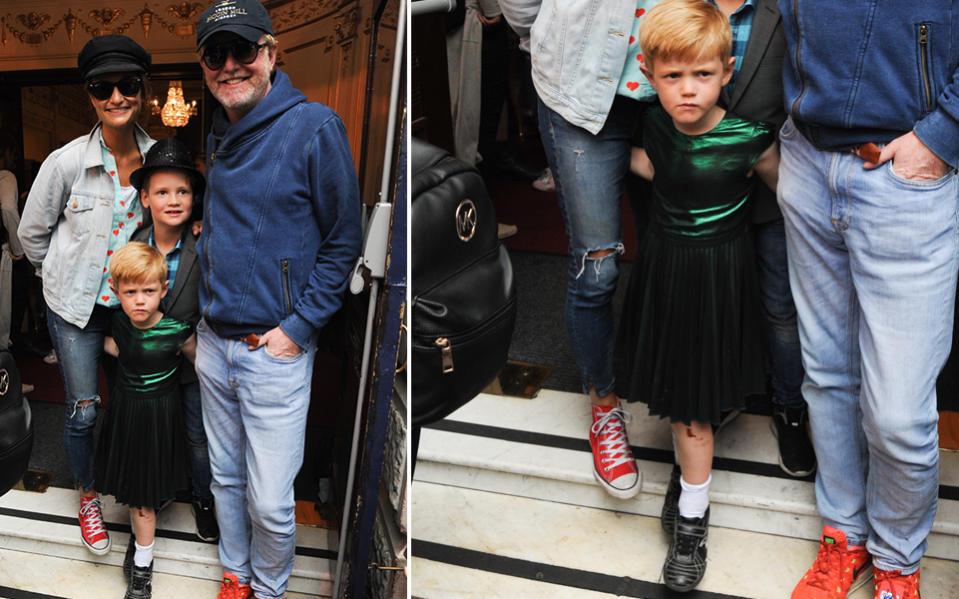When Little Boys Want to Wear Dresses
Though statistics about how many pre-adolescent boys sometimes wear dresses are scant, studies estimate that about 2 percent to 7 percent behave in “cross-gender” ways. And this week, two sons of celebs became the latest to express themselves in gender-bending ways. Both have gotten largely praised in the media.

“The most darling thing you have ever seen!” declared Perez Hilton, in writing about how Megan Fox shared a photo on Instagram of her 4-year-old son Noah in an Elsa dress — a proclivity of her son’s that she’s shared with the public before, once telling Jimmy Kimmel, “The boys can wear dresses. Noah wears dresses, so there are no rules — you can be whatever you want to be in my house!”
Other media outlets noted that Noah “rocked” the Elsa dress and looked “sweet”; although social media commenters had more mixed opinions, with some criticizing the decision to let Noah wear the dress. “Confusing the little-boy mind from an early age that they can’t decide what they want of their own. Transgender in the process. Selfish people!” offered one Instagram critic.
A post shared by Megan Fox (@the_native_tiger) on Jul 31, 2017 at 8:51pm PDT
Meanwhile, U.K. television and BBC radio producer Chris Evans posed with his family on Tuesday for a London paparazzi shot that included his son Eli, 5, wearing a glam green frock. That, too, received mixed reactions, with one media outlet writing that he “steals the show” with his “forward-thinking dress sense.” Others on social media did not approve, however. “What is it with these celebrities making their little boys wear dresses?” wondered one Twitter user.
The boys are not the first and certainly won’t be the last to cause a mix of emotions from onlookers because of their gender-bending aesthetic. In late July, Liev Schreiber’s son Kai, 8, dressed up as Harley Quinn for the San Diego Comic-Con, and people had feelings. Before that, Charlize Theron’s son Jackson, 4, dressed as a princess, prompting similar controversy.
Regular moms have also gotten lots of attention for proudly sharing images of their sons in dresses, as have books addressing the topic, such as Morris Micklewhite and the Tangerine Dress, which caused an uproar at a Michigan elementary school.
So how can a mom or dad best respond to their little boys wanting to experiment with gender-creative expression through dresses or princess costumes or nail polish — particularly parents for whom such requests could trigger worry or fear for their child?
“All those feelings a parent might have? Don’t push them under the rug,” Diane Ehrensaft, developmental and clinical psychologist and author of The Gender Creative Child, tells Yahoo Style. “Filter them, tag them, and put them in cold storage, even if it involves a bit of performance. Then say, ‘Dresses are people clothes, and if those are what you want to wear, that’s beautiful.’ I can’t tell you how important it is for a child to get positive feedback about gender-expansive behavior.”
That’s because, explains the founding member of the Child and Adolescent Gender Center in San Francisco, “it may be a very core part of who he is. And the last thing you want to do is instill shame, rather than pride.”
Still, what about preparing such a boy for the possibly hurtful reactions of others? Ehrensaft explains that how a parent approaches giving such a warning should differ based on the child’s constitution.
“Some kids need that guidance more than others — some may say ‘I don’t care what anyone thinks,’ while some are very sensitive about teasing,” Ehrensaft explains. For the latter, she says, a parent could advise something like the following: “I just want you to know there are some kids who might not understand, and will be confused, and they may say some not-nice things. What would you like to do about that?”
A parent might also suggest ways to teach the critics or bullies points, including how dresses are “‘not girl clothes, but people clothes.’ So you give them something to pull out of a toolbox,” she says. Making sure that there’s a supportive adult around when your boy experiments with gender-creative dress — such as by giving his teacher or camp counselor a heads up — is hugely important, Ehrensaft stresses.
And there are always supportive people who can help boost a child’s self-confidence, such as the Instagram commenter who left the following thoughts on Fox’s image: “Beautiful pictures of a beautiful family. I’ll never understand why people are getting so upset over a dress. Boy things/girl things. … How about simply ‘kid things’ without the labels.”
Read more from Yahoo Style + Beauty:



